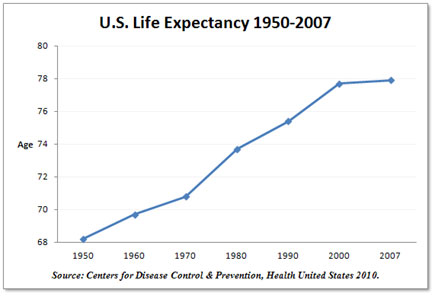 Constant media news stories and alleged dangers associated with chemicals along with and activist hype has blurred reality about the importance of chemicals in human progress. Worldwide, the average human life span has increased from about 30 years at the beginning of the 20th century to more than 60 years today, and it continues to rise.(1) In the United States, life expectancy in 1900 was just 47 years, but today it has reached nearly 78 years according to one estimate (see chart). The freedom to develop and but to use thousands of man-made chemicals has played a crucial role in that progress by making possible such things as pharmaceuticals, safe drinking water, and pest control.
Constant media news stories and alleged dangers associated with chemicals along with and activist hype has blurred reality about the importance of chemicals in human progress. Worldwide, the average human life span has increased from about 30 years at the beginning of the 20th century to more than 60 years today, and it continues to rise.(1) In the United States, life expectancy in 1900 was just 47 years, but today it has reached nearly 78 years according to one estimate (see chart). The freedom to develop and but to use thousands of man-made chemicals has played a crucial role in that progress by making possible such things as pharmaceuticals, safe drinking water, and pest control.
Yet the public perception is that man-made chemicals are the source of every possible ill, from cancer to ozone depletion and from infertility to brain damage. Ignoring that nature produces far more chemicals at far higher doses and that most chemicals are innocuous at low doses, activists capitalize on those fears. They scare the public by hyping the risks to ensure that the government passes volumes of laws and regulations focused on eliminating chemicals without much regard for the tradeoffs.
Advocates of such limits want the government to make sure every chemical is safe before exposing the public. In his 2000 book Pandora’s Poison, Greenpeace’s Joe Thornton calls on society to follow the “precautionary principle,” which says “we should avoid practices that have the potential to cause severe damage, even in the absence of scientific proof of harm (page 10).” We should shift the burden of proof, he continues. Those individuals or firms introducing new chemicals must prove the chemicals are safe before introducing them into commerce, and those chemicals already in commerce which fail to meet this standard “should be phased out in favor of safer alternatives.”
The problem is that no one can ever prove that anything is 100 percent safe. Not surprisingly, Thornton also advocates a “zero discharge” policy, which calls for the elimination of all bioaccumulative chemicals. In particular, he has long called for the elimination of chlorine. Science magazine quotes him as noting: “There are no known uses for chlorine which we regard as safe.”(2) Perhaps in recognition that this standard is politically untenable, he suggested in Pandora’s Poison (p. 14) that chlorine use be continued for “some pharmaceuticals” and some “water disinfection,” but only until other options become available.
The Dangers of Precaution
But before we call for zero discharge of anything, we should think about what that means. Like anything, chemicals may create new risks, but they have been used to eliminate others—many of which wreaked havoc on civilization for centuries. As the Competitive Enterprise Institute’s Fred Smith notes, “Experience demonstrates that the risks of innovation, while real, are vastly less than risks of stagnation.” Indeed, he asks, what would the world be like if medical researchers had never introduced penicillin because they could not prove it was 100 percent safe?
Chemicals Transform Our Everyday Lives
Although we don’t think much about them, man-made chemicals are essential to almost everything we do. They make our cars run; they clean everything from our teeth to our dishes; they reduce illness by disinfecting bathrooms at home and operating rooms in hospitals; they are used on food products, such as poultry, to eliminate E. coli and other deadly pathogens; and they keep our computers, television sets, and other electronic products running. Consider just a few of the critical functions they perform in making our lives better:
- Chlorination of water supplies has saved millions of lives. For example, since local engineers and industry introduced chlorination in the 1880s, waterborne-related deaths in the United States dropped from 75 to 100 deaths per 100,000 people to fewer than 0.1 death per 100,000 annually in 1950.(3)
- Rather than curtailing the use of chlorination as Thornton suggests, we should be expanding access. According to the World Health Organization, because of such problems as poor sanitation and unsafe drinking water diarrheal diseases (such as cholera and dysentery) kill about 2.2 million people a year, most of whom are children under five years of age.11
- The U.S. Centers for Disease Control and Prevention notes that fluoridation of water (fluoride is yet another chemical targeted by environmentalists) has proven a tremendous benefit for oral hygiene.
- Nearly 85 percent of pharmaceuticals currently in use require chlorine to be used in their production.
- Thanks to chemicals used for pharmaceuticals, combination drug therapy reduced AIDS deaths by more than 70 percent from 1994 to 1997.14 Researchers estimated that AIDS drug treatments have saved a total of 3 million years of life in the United States since 1989.(4)
- Fifty percent of the reductions of heart disease–related deaths between 1980 and 1990 (total death rate decline of 30 percent) are attributable to medicines and the chemicals that are in them.
- Chemicals called phthalates (there are several kinds of phthalates) are used in polyvinyl chloride (PVC)—a type of vinyl used for medical tubing, blood bags, and numerous other products. Although environmentalists have tried to ban these products, vinyl medical devices provide numerous lifesaving benefits. PVC is a safe, durable, sterile product that can withstand heat and pressure, as well as produce tubing that doesn’t kink. It is particularly beneficial for vinyl blood bags because it stores blood twice as long as the next best alternative and doesn’t break as glass alternatives do. With blood shortages looming, PVC blood bags are an essential tool in maintaining and transporting supply.
- Biocidal chemicals may soon find their way into hospital uniforms and other textiles used in hospitals, thereby helping to prevent such materials from carrying bacteria and transmitting them to patients. Diseases acquired in hospitals account for as many as 80,000 deaths a year, and studies have found that bacteria can survive long periods on worker’s uniforms—making them vehicles for infection. If antitechnology activists don’t try to ban them first, biocidal chemicals may soon help save thousands of lives every year.
- Thanks to modern farming with chemicals, food production has outpaced population growth—providing people in both developed and developing countries with more food per capita. Per capita grain supplies have grown by 27 percent since 1950, and food prices have declined in real terms by 57 percent since 1980.(5)
- Using herbicides to control weeds decreases the need for tilling soil, which, in turn, reduces soil erosion by 50 to 98 percent.(6)
- Because of high-yield farming (which uses chemical fertilizers, pesticides, herbicides, etc.), farmers feed more people while farming less land—leaving more land for wildlife. If farmers continued to use 1950s technology—when most of the world did not use pesticides and fertilizers—they would have to plant 10 million square miles of additional land to generate the food that produced today.(7) That’s more land than all of North America (which is about 9.4 million square miles and almost as much as all the land in Africa (which is about 11.7 million square miles).
- Many of us enjoy drinks with artificial sweeteners to avoid extra calories. These chemicals are an important benefit to diabetics. As with so many chemicals, activists once tried to ban saccharin by claiming it was a carcinogen. That myth was dispelled in May 2000 when the Department of Health and Human Service removed saccharin from its list of human carcinogens. Despite that finding, activists complained when Congress eliminated the law that saccharin carry a cancer warning label.
- Mercury—a heavy metal that is often a target of environmentalists—is a key component of the amalgam fillings that have eliminated and prevented billions of toothaches during more than four decades of use. Mercury has long been a key target of antichemical activists. However, in the early 1990s, public health providers and government researchers debunked claims about the dangers of mercury in amalgam fillings. The American Dental Association called such claims fraudulent, and some doctors had their licenses suspended and paid hefty legal compensation in cases where they had convinced patients to remove fillings on such dubious grounds. For more information see this article on Quackwatch.
At question should not be whether firms use chemicals, but whether they use chemicals responsibly and what is gained in return. Firms can reduce chlorine in attempts to appease environmentalists, but are we willing to drink water swimming with microbial contaminants and give up lifesaving pharmaceuticals?
(1) Nicholas Eberstadt, “World Population Prospects for the Twenty-First Century: The Specter of ‘Depopulation’?” in Earth Report 2000, ed. Ronald Bailey (New York: McGraw Hill, 2000), 65.
(2) Ivan Amato, “The Crusade against Chlorine,” Science 261, no. 5118 (1993): 153.
(3) J. Michael LaNier, “Historical Development of Municipal Water Systems in the United States, 1776–1976,” Journal of the American Water Works Association 68, no. 4 (1976): 177.
(4) Rochelle P. Walensky, et al., “The Survival Benefits of AIDS Treatment in the United States,” Journal of Infectious Diseases 194, no. 1 (July 1, 2006): 11–19.
(5) Dennis Avery, “Saving the Planet with Pesticides,” in The True State of the Planet, ed. Ronald Bailey (New York: Free Press, 1995), 52–54.
(6) Ibid.
(7) Ibid.
Last updated: February 6, 2012. The original text for this article was drawn from Angela Logomasini, “Chemical Risk Overview,” in Environmental Source, eds., Angela Logomasini Ph.D. and David Riggs, Ph.D., published by Competitive Enterprise Institute, 2002 (1st ed.), 2008 (2nd ed).

